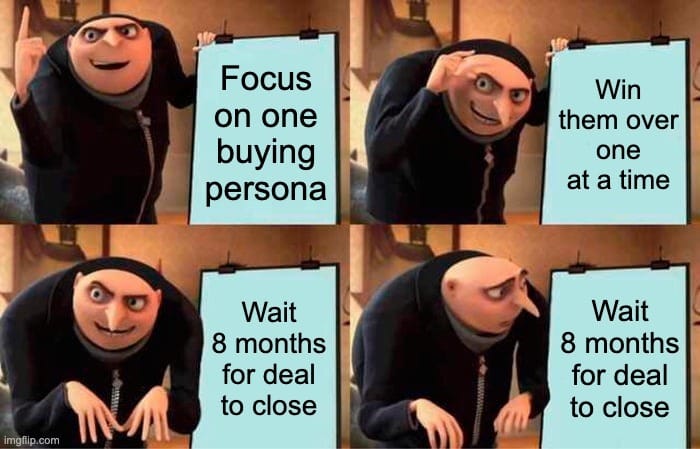Invite your bot: It’s true, bots love webinars. The Vibe Your SaaS monthly webinar series continues. For June, I asked Reddit marketing mastermind Paul Xue to share his secrets with us on June 25 at 9:00 AM Pacific. Register here for it →

How to Make Enterprise Sales Close Faster (Asking For a Friend)
The number one question founders ask me is, “How do we make deals go faster?”
To which I answer, “It’s simple, you need to sell everyone at the same time.”
Enterprise deals don’t move slowly because people don’t like your product. They move slowly because there are 6 to 12 people on the buying committee. Most teams focus on one buying persona and stumble through the others (hopefully), winning them over one at a time. This is why most deals stall.

Here’s what works to make enterprise deals go faster:
1. Engage the Entire Buying Committee Simultaneously
Don't wait for your champion to "pass things along." You need the CIO seeing security content, the CFO seeing ROI case studies, the CTO reading technical docs, and the team leads seeing how it affects daily work. To move faster, influence everyone at once.
Takeaway: Bypass your champion and reach out to every decision maker directly.
2. Stop Thinking of Sales as a Straight Line
Enterprise buying isn’t a linear funnel (even though I like that analogy and even made a video about it years ago). It’s a group of people with different agendas trying to make sense of one solution. No one person makes the call. They all have to piece it together and feel confident at the same time.
Takeaway: Enterprise buying is group consensus, not individual conversion.
3. Create Urgency by Highlighting Risk
People don't buy because they want to. They buy because standing still feels expensive. Content that highlights risk, loss, and cost of inaction speeds up group alignment. But also leverage competitive intelligence: "Your biggest competitor just went live with this capability" creates immediate urgency.
Takeaway: Make standing still scarier than moving forward.
4. Make Your Value Clear for Each Role
The CFO doesn’t care about faster workflows. The engineering lead doesn’t care about cost savings. You need to give everyone in the buying group a reason to say yes. And for each person, the reason is different. Tailor the message.
Takeaway: Same product, different reasons to buy for each person.
5. Bring in Legal and Procurement Early
Most deals stall here because the legal team sees the contract for the first time at 11:59 PM, just before your close date. A simple line like "How do we loop in legal now, just in case?" saves weeks later. Better yet: "What's the one thing legal always changes in contracts?" Then fix it before they see it.
Takeaway: Fix contract issues before they become deal killers.
6. Help Your Champion Win the Internal Sale
They’re pitching this internally, usually without you in the room. Provide them with targeted case studies, one-pagers, ROI numbers, and any other materials that help them convince their team.
Takeaway: Arm them with ammunition for rooms you're not in.
7. Secure Executive Air Cover Early
Don't just meet the executive, find a way to make them your champion. Frame your solution around their top 3 business priorities. When an executive publicly champions your solution in internal meetings, middle management stops creating obstacles.
Takeaway: When the boss says yes, middle management stops saying no.
8. Build Content for Each Persona
Stop with the generic PDFs. Create specific content that addresses each role’s concerns. Case studies for finance, implementation guides for IT and engineering, and productivity stories for the end users. Then distribute that content across email, LinkedIn, and ads. All at the same time.
Takeaway: Generic materials lose to targeted messaging.
9. Leverage Strategic References
Generic references don't work. Match prospects with customers who share their industry, size, and specific challenges. Brief your reference on the prospect's concerns beforehand. Nothing beats hearing "this actually worked" from a peer who solved identical problems.
Takeaway: Peer validation beats vendor promises.
10. Time It to Their Budget Cycle
Understand their fiscal calendar and budget approval process. Most enterprises plan 6-12 months ahead, but have quarterly re-forecasting. Align your close timeline with when they actually have money to spend.
Takeaway: Sell when they have money to spend.
11. Prove It Works Before They Buy
Technical validation through POCs or pilots eliminates the biggest objection: "Will this actually work in our environment?" Make the proof process fast and focused on their specific use case.
Takeaway: Remove "will this work?" from the equation.
12. Help Your Contact Sell It Internally
Create detailed go-live plans that show exactly how success is achieved. When buyers can visualize the path from purchase to value realization, purchase anxiety drops. Assign customer success managers during the sales process, not after.
Takeaway: Show the path from purchase to value.
13. Use a Mutual Action Plan to Close
Once the deal is real, co-create a timeline. Not just “we’ll send a contract,” but a clear path to launch. “If you want to be live by X date, here’s what has to happen on both sides.” That kind of alignment fosters trust and keeps things moving forward.
Takeaway: Shared timelines create shared accountability.
14. Get Good at FUD
FUD (Fear, Uncertainty, and Doubt) is a challenging concept for many to master, but it is essential in enterprise sales.
Takeaway: Make buyers more afraid of inaction than action.

The Bottom Line: Enterprise Sales is Like Herding Cats, But the Cats Have Budgets
Enterprise buyers move slowly because they're terrified of making the wrong choice, not because they're indecisive.
Your job is to make them more afraid of standing still than moving forward.
Stop thinking like a vendor. Think like a consultant solving a problem they can't afford to ignore. Make buying feel inevitable, instead of optional.
The Gregory and Paul Show With Guest Arjun Dev Arora - Friday, June 13, 2025
On the Gregory and Paul Show, we break down the latest in startups, SaaS, AI, and whatever the internet is debating this week. We aim for smart takes, and many times end up with dumb ones, but will hit a couple of scorchers, and we love memes way too much. We stream live on X and LinkedIn at Noon every Friday, then straight on to YouTube.
On this episode, we chat with early-stage super-duper-startup-advisor Arjun Dev Arora. He was an early backer of Flexport, Notion, Virta & more.
Free Vibe Your SaaS Resources
100 Reasons Customers Say “No” (And How to Make Them Say “Yes”): A Comprehensive Google Sheet breaks down 100 fixes. Get the tool →
"Every marketing channel sucks right now": 19 unconventional Vibe Marketing ideas that Founders can harness. Get the free presentation →
30-Day SaaS Growth Plan Template: Designed For Technical Founders Who’d Rather Be Building. Get the free eBook →
How to get your first 1,000 followers on 𝕏: Building a large following on 𝕏 in 2025 is still possible. Get the free eBook →
VC Pitch Deck Templates for Founders: Based on the legendary Sequoia deck, built for real fundraising. Get the free templates →

What’s a Micro-Fractional CMO
A micro-fractional CMO (Chief Marketing Officer) is a marketing executive who works with a company for a limited amount of time, typically just a few hours per week or month, providing high-level strategic marketing guidance without the cost or commitment of a full-time or traditional fractional CMO. They're ideal for startups or small businesses needing expert input on a tight budget.
🔥 Why Go Micro-Fractional?
Strategic Firepower, Zero Bloat
You get executive-level marketing leadership without paying for a full-time hire or building a large team. It's lean, fast, and effective.
Perfect for Founders Who Can’t Hire Yet
You’re not ready for a full-stack marketing team, but you need direction, clarity, and traction. A micro-fractional CMO bridges that gap.
AI-First, Not Agency-First
Skip overpriced agencies and bloated retainers. A micro-fractional CMO can harness AI tools to move faster and smarter, getting you 80% of the results with 20% of the cost.
Focused on Traction, Not Vanity
No fluffy brand decks unless they drive growth. The focus is always on product-market fit, lead generation, and momentum.
🎯 Ready to Level Up?
If you're tired of marketing guesswork and wasted spend, let's change that.
I'm Gregory Kennedy, former creative director, 3x head of marketing, and founder of Vibe Your SaaS. I help early-stage startups build real momentum with strategic clarity, AI-driven execution, and zero BS.
Book a call and let’s make your marketing actually work.
Greogry Kennedy // Vibe Your SaaS // www.vbmrktr.com



